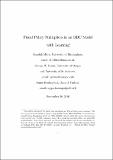Files in this item
Fiscal policy multipliers in an RBC model with learning
Item metadata
| dc.contributor.author | Mitra, Kaushik | |
| dc.contributor.author | Evans, George W. | |
| dc.contributor.author | Honkapohja, Seppo | |
| dc.date.accessioned | 2016-10-17T23:34:03Z | |
| dc.date.available | 2016-10-17T23:34:03Z | |
| dc.date.issued | 2019-01 | |
| dc.identifier | 246755262 | |
| dc.identifier | ae6e3e18-6731-4aa0-a2d0-bb70c214ef76 | |
| dc.identifier | 85023186978 | |
| dc.identifier | 000461045600009 | |
| dc.identifier.citation | Mitra , K , Evans , G W & Honkapohja , S 2019 , ' Fiscal policy multipliers in an RBC model with learning ' , Macroeconomic Dynamics , vol. 23 , no. 1 , pp. 240-283 . https://doi.org/10.1017/S1365100516001176 | en |
| dc.identifier.issn | 1365-1005 | |
| dc.identifier.uri | https://hdl.handle.net/10023/9677 | |
| dc.description | This work was supported by ESRC Grant RES-062-23-2617 and National Science Foundation Grant no. SES-1025011. | en |
| dc.description.abstract | Using the standard real business cycle model with lump-sum taxes, we analyze the impact of fiscal policy when agents form expectations using adaptive learning rather than rational expectations (RE). The output multipliers for government purchases are significantly higher under learning, and fall within empirical bounds reported in the literature, which is in sharp contrast to the implausibly low values under RE. Positive effects of fiscal policy are demonstrated during times of economic stress like the recent Great Recession. Finally it is shown how learning can lead to consumption and investment dynamics empirically documented during some episodes of “fiscal consolidations.” | |
| dc.format.extent | 585523 | |
| dc.language.iso | eng | |
| dc.relation.ispartof | Macroeconomic Dynamics | en |
| dc.subject | Government purchases | en |
| dc.subject | Expectations | en |
| dc.subject | Output multiplier | en |
| dc.subject | Fiscal consolidation | en |
| dc.subject | Taxation | en |
| dc.subject | HB Economic Theory | en |
| dc.subject | NDAS | en |
| dc.subject | BDC | en |
| dc.subject.lcc | HB | en |
| dc.title | Fiscal policy multipliers in an RBC model with learning | en |
| dc.type | Journal article | en |
| dc.contributor.sponsor | Economic & Social Research Council | en |
| dc.contributor.institution | University of St Andrews. School of Economics and Finance | en |
| dc.identifier.doi | 10.1017/S1365100516001176 | |
| dc.description.status | Peer reviewed | en |
| dc.identifier.grantnumber | RES-062-23-2617 | en |
This item appears in the following Collection(s)
Items in the St Andrews Research Repository are protected by copyright, with all rights reserved, unless otherwise indicated.

